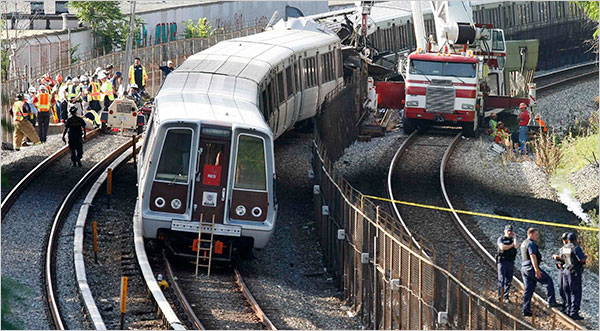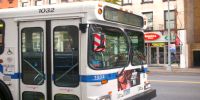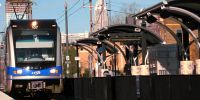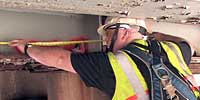Tom McNamara, Blueprint America
 D.C. Metro crash || Photo: Reuters D.C. Metro crash || Photo: Reuters |
The Monday Metro accident in Washington, D.C., when a train car rear-ended another killing nine people, involved some of the oldest cars in the city’s young subway system. The cars had already been said to have vulnerabilities. Washington, however, is not the exception for using equipment that is outdated.
Earlier this year, in a two-part report on The NewsHour with Jim Lehrer, Blueprint America reported on the financial state of America’s mass transit systems, and focused on Washington, D.C.
[sorry, this video no longer available]
More than a third of the equipment in the nation’s seven largest rail transit agencies, according to a recent report by the Federal Transit Administration, is rated in marginal or poor condition.
Still, it has yet to be determined if the old age of the Metro cars in Monday’s crash caused the accident.
Nationally, according to The New York Times, “Replacing all the equipment that has exceeded its useful life and finishing all outstanding station rehabilitations for just those seven large systems would cost roughly $50 billion, the agency estimated, and keeping the systems in a state of good repair after that would cost an estimated $5.9 billion a year.”
The stimulus law passed in February only contains $8.4 billion for transit capital improvements across the nation. That said, the recently introduced transportation bill will dedicate more funding than ever for transit. The Obama Administration, however, wants to delay that funding increase for at least 18-months.
Washington transit officials said they could not afford to replace the outdated cars, which make up more than a quarter of their system. Moreover, due to the terms of a complicated tax shelter, the city is obliged to keep like-cars in service until 2014.
The New York Times goes on to say, “Paying for capital improvements has been a struggle for many agencies. Although federal financing for capital improvements to transit systems has been rising, the share going to the largest systems has been shrinking as they have had to compete with new, smaller systems. So while the nation’s seven largest systems — in New York, Boston, Chicago, Philadelphia, Washington, New Jersey and San Francisco — carry 80 percent of the nation’s rail riders, and are in many cases among the oldest systems, they have received only 23 percent of federal financing eligible for bringing systems into a state of good repair, according to the transit administration.”
The following is a breakdown of how mass transit is funded federally:
[Transit Capital Assistance] [Fixed Guideway (Rail) Infrastructure Investment] [Capital Investment Grants] [Federal Transit Administration Formulas]
$8.4 billion total in stimulus spending for mass transit |
|
|---|---|
 TRANSIT CAPITAL ASSISTANCE TRANSIT CAPITAL ASSISTANCE |
|
| $6.9 billion | The stimulus bill provides $6,900,000,000 instead of $8,400,000,000 as proposed by the Senate and $7,500,000,000 as proposed by the House.
In addition, mass transit funding in the stimulus bill provides 2.5 percent of the rural funds for tribal transit needs and includes $100,000,000 (instead of $200,000,000 as proposed by the Senate) for discretionary grants to public transit agencies for capital investments that will assist in reducing the energy consumption or greenhouse gas emissions of their public transit agencies. |
 FIXED GUIDEWAY (RAIL) INFRASTRUCTURE INVESTMENT FIXED GUIDEWAY (RAIL) INFRASTRUCTURE INVESTMENT |
|
| $750 million | The stimulus bill provides $750,000,000 instead of $2,000,000,000 as proposed by the House. The Senate did not include a similar provision.
|
 CAPITAL INVESTMENT GRANTS CAPITAL INVESTMENT GRANTS |
|
| $750 million | The stimulus bill provides $750,000,000 instead of $2,500,000,000 as proposed by the House. The Senate did not include a similar provision.
|
| FEDERAL TRANSIT ADMINISTRATION (FTA) FORMULAS |
|
| Urbanized Formula | the formula: Primarily, the urbanized formula is based on population and population density. An urbanized area, accordingly, is an incorporated area with a population of 50,000 or more.For areas of 50,000 to 199,999 in population, the formula is based solely on population and population density. The funds are apportioned to the Governor of each state for distribution.For areas with populations of 200,000 or more, the formula is based on not just population and population density but also a combination of bus revenue vehicle miles, bus passenger miles, fixed guideway revenue vehicle miles, and fixed guideway route miles. Funds are not apportioned to a Governor but rather go directly to a designated recipient selected locally (most often, a responsible local official or operator of a public transit service) to apply for and receive federal funds.
A few areas under 200,000 in population have been designated as transportation management areas and receive funding directly. eligible purposes: Federal funding according to the Urbanized Formula can be used for planning, engineering design and evaluation of transit projects and other technical transportation-related studies; capital investments in bus and bus-related activities such as replacement of buses, overhaul of buses, rebuilding of buses, crime prevention and security equipment and construction of maintenance and passenger facilities; and capital investments in new and existing fixed guideway systems including rolling stock, overhaul and rebuilding of vehicles, track, signals, communications, and computer hardware and software. All preventive maintenance and some Americans with Disabilities Act complementary paratransit service costs are considered capital costs. the match: The federal share of a mass transit project cannot exceed 80 percent of the net project cost. Exceptions: The federal share may be 90 percent for the cost of vehicle-related equipment needed to comply with the Americans With Disabilities Act and the Clean Air Act; The federal share may be 90 percent for projects related to bicycles. The federal share cannot exceed 50 percent of the net project cost of operating assistance. funding availability: Year appropriated plus three years (total of four years). |
| Rural Formula | the formula: Only for areas less than 50,000 in population, the Rural Formula is based on nonurbanized population and land area. The breakdown: 80 percent of the formula is determined by the nonurbanized population of a state; 20 percent of the formula is based on land area – no State can receive more than 5 percent of the amount apportioned for land area.
The FTA also adds amounts based on the nonurbanized population according to the Growing States Formula. Eligible recipients are state and local governments, Indian tribes, non-profit organizations and public transit operators. eligible purposes: Funds may be used for capital, operating, and administrative purposes. The amount that a state can use for administration, planning, and technical assistance is limited to 15 percent of the annual apportionment. States must spend 15 percent of the apportionment to support rural intercity bus service unless the Governor certifies, after consultation with affected intercity bus providers, that the intercity bus needs of the state are sufficient. the match: The federal share for capital and project administration is 80 percent. Exceptions: The federal share may be 90 percent only if it is needed to comply with the Americans with Disabilities Act, the Clean Air Act or bicycle access projects. The maximum federal share for operating assistance is 50 percent of the net operating costs. funding availability: Year appropriated plus two years (total of three years). |
| Growing States and High Density Formula | The formula establishes new factors to distribute funds to the urbanized area formula and rural formula programs.One-half of the funds that are made available under the Growing States factors are apportioned by a formula based on state population forecasts for 15 years beyond the most recent census; amounts apportioned for each state are then distributed between urbanized areas and rural areas based on the ratio of urban/rural population within each state.
The High Density States factors distribute the other half of the funds to states with population densities over 370 persons per square mile. These funds are apportioned only to urbanized areas within those states. |
Sources: Congressional Budget Office, Department of Transportation – Federal Transit Administration, House Committee on Transportation and Infrastructure, House Committee on Rules, Joint Committee on Taxation


